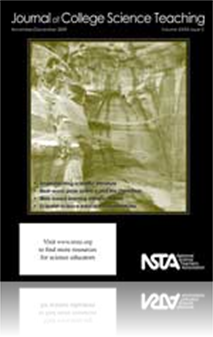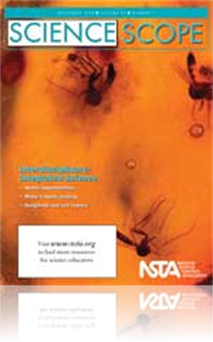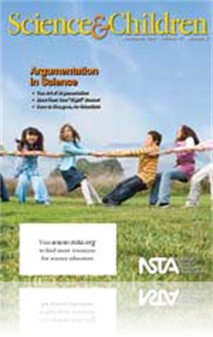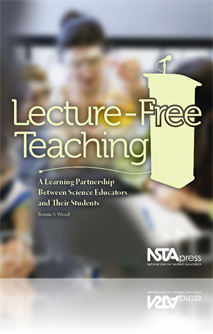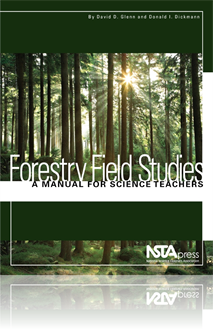All Resources
Journal Article
Point of View: How Are We Reforming Teaching in Undergraduate Science Courses?
A study of a national population of 103 higher education institutions is addressing the question: What criteria can be used to identify the level of implementation of reform in an undergraduate science course? Results of a survey characterizing the i...
Journal Article
Favorite Demonstration: Structure—Function Lab in a Bag
This hands-on activity stimulates students to consider the close relationship between structure and function. This inquiry-type lab can be done as a group or cooperative learning experience using simple kitchen tools. The activity provides a fun ice-...
Journal Article
Bridging the Gap Between Real-World Polar Science and the Classroom
The International Polar Year—Research and Educational Opportunities in Antarctica for Minorities (IPY-ROAM) program was designed to increase minority participation in polar science by immersing participants in an academic program that included a tr...
Journal Article
Safer Science: Sun Safety—The Stats
Science teachers can help protect themselves and their students by providing information on skin cancer, its causes, and prevention strategies. This is not just a summer issue, but one that affects us year-round! This month’s column provides preven...
Journal Article
This article describes how our common addiction to cell phones was used to launch a discussion about their use, impacts on the environment, and connections to issues of civic concern. By encouraging middle school science students to adopt the perspec...
Journal Article
This article describes a research study in which a biologist and his research on Antarctic seabirds became part of an integrated science course for prospective elementary teachers. Students used the scientist’s database on seabird chick growth rate...
Journal Article
A Versatile Module to Improve Understanding of Scientific Literature Through Peer Instruction
Using primary literature in undergraduate science classes helps teach students both scientific information and process. However, students’ lack of understanding of scientific techniques can hinder their understanding of the papers. This article des...
Journal Article
Career of the Month: An Interview With Urologist Chad DeRosa
The organs, tubes, muscles, and nerves that work together to create, store, and carry urine make up the urinary system. Urologists are surgeons that focus on diseases of this system—which includes the kidneys, ureters, bladder, supporting muscles a...
Journal Article
How can you connect, supplement, and extend students’ firsthand investigations? Look toward your bookshelves for a clue. Books and other textual materials can serve the following roles in support of scientific inquiry: providing context, modeling, ...
Journal Article
Attitudes toward science may develop as early as middle school and often differ between genders. Do these gender-based differences in attitude persist into the college years? In a survey of 376 university students, male students reported a stronger s...
Journal Article
This study is an experimental introduction of web-based lecture delivery into a majors-level introductory biology course. Web-based delivery, achieved through the use of prerecorded Voice-Over PowerPoint video lectures, was introduced on a limited ba...
Journal Article
Argument-Driven Inquiry (ADI) is an instructional model that enables science teachers to transform a traditional laboratory activity into a short integrated instructional unit. To illustrate how the ADI instructional model works, this article describ...
Journal Article
Application of the K-W-L Teaching and Learning Method to an Introductory Physics Course
The K-W-L method of teaching is a simple method that actively engages students in their own learning. It has been used with kindergarten and elementary grades to teach other subjects. The authors have successfully used it to teach physics at the coll...
Journal Article
Students can’t ask for much more fun than skateboarding during class time. With some additional concept learning, that kind of fun can be incorporated into a debate that encourages students to practice scientific argumentation. With a debate comes ...
Journal Article
Everyday Engineering: Time’s up, turkey—Pop-up thermometers
Meat thermometers can be awkward to use in terms of placement and avoidance of bones. Because of these problems, each year 30 million Thanksgiving turkeys have a built-in thermometer that pops up when the turkey is properly cooked. Turkey timers are ...
Journal Article
Editor’s Note: Arguing Versus Scientific Argumentation
Scientific argumentation is a valid and effective way to involve students in voicing their opinions based on evidence. It helps in the development of scientific thinking and provides opportunities for students to ask more questions. But, just turning...
Journal Article
Scope on Safety: Signs of safer science
Can you imagine trying to put out a fire and finding the fire extinguisher? Experiencing a short circuit and having to search for the master electrical shutoff? Having a hazardous chemical splash and not being able to locate the eyewash station? Thes...
Journal Article
Argumentation in science involves offering and responding to claims, providing and asking for evidence or justifications, and analyzing those claims to formulate a decision (Gross 1990). The authors’ experience with students, including those who ar...
Journal Article
Solving the Mystery of Mock Mummies: Using Scientific Inquiry Skills in an Integrated Lesson
When the nature of science (NOS) is reinforced, middle school students will be able to appreciate scientific inquiry processes and communication, as outlined in the National Science Education Standards (NRC 1996). To this end, the authors developed a...
Book Chapter
The Content-Understanding-Environment (C-U-E) framework incorporates key findings from research and is easy to use and remember. Further, current professional development for science teachers usually focuses on only one aspect of teaching and learnin...
Book Chapter
The strategies associated with the “Content” aspect of the framework help keep us focused on the question “Why am I doing this?” Clearly, we need to know and be able to articulate why we are addressing particular content in our lessons and ho...
Book Chapter
This chapter focuses on strategies you can use as you work with students to develop their understanding of science concepts. After reviewing the research on effective science instruction, six instructional strategies are provided to help develop stud...
Book Chapter
Content and understanding strategies contribute in large measure to the instruction we provide. Yet the effectiveness of the most carefully crafted lessons and instruction will be enhanced or undermined by the classroom climate—including relationsh...
Book Chapter
The Content-Understanding-Environment instructional framework presented in this book is meant to add some tools to your toolbox. Many of the tools are ones that you already use, but others may be sitting on your workbench waiting for a chance to be p...
Book Chapter
The Chronology of Course Design
Although the unpredictability of leading a lecture-free class may be unsettling at first, the author encourages you to embrace the energy that accompanies this pedagogy. Flexibility and responsiveness to what happens during each class meeting with ea...
Book Chapter
Forest History, Ecology, and Values
Forests have been crucial to human welfare since the dawn of civilization. The history of both the Old World and the New World contains many examples of civilizations that failed because they could not sustain their wood supplies and maintain the for...
Book Chapter
The core value of forestry is the long-term sustainability of forests. Sustainability can be accomplished only if we understand ecological processes and respect them; then we can creatively protect and shape forests to satisfy the needs of future gen...
Book Chapter
Unquestionably, conducting successful field studies with high school or beginning college students is complicated, energy consuming, and challenging. Nonetheless, putting students in the field to collect real data, analyze the data, and eventually dr...
Book Chapter
Mapping the structure of the vegetation in study plots is important for several reasons. First, with all the detailed data collected, students easily can lose perspective of the bigger picture; they can get lost in the trees and not see the forest, s...
Book Chapter
The Abiotic and Biotic Forest Environment
The exercises in this chapter have a twofold purpose. First, they will characterize the abiotic environment (i.e., the microclimate created by the forest). It is important to realize that forests not only grow in response to the local climatic factor...
Book Chapter
Measuring Commercial Timber Values
This chapter outlines certain procedures used by foresters to measure the amount or volume of timber (primarily sawlogs) in a forest stand. This process is called timber inventory. Just as a storeowner keeps track of the inventory of stock on hand at...
Book Chapter
In fiscal year 2007, there were more than 178.6 million visits to national forests across the United States; 86% of them were for recreational purposes! Forests of all kinds provide humans with a wide range of wildland recreational opportunities, whi...
Book Chapter
Students are out of the field and back into the classroom. In this chapter, students are provided with a Forestry Data Summary Sheet to help them focus on all the computations, sketches, charts, and data they need to construct and write their report....
Journal Article
Many students have recently asked about the “swine flu.” How is it different than the seasonal flu, what are the symptoms, and what can we do to avoid it?...



